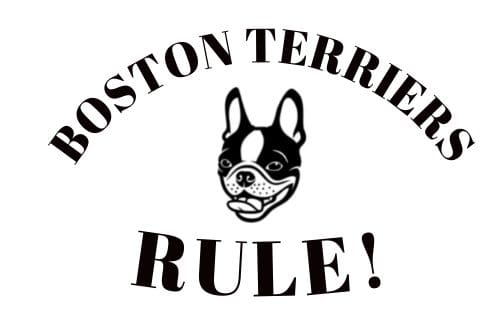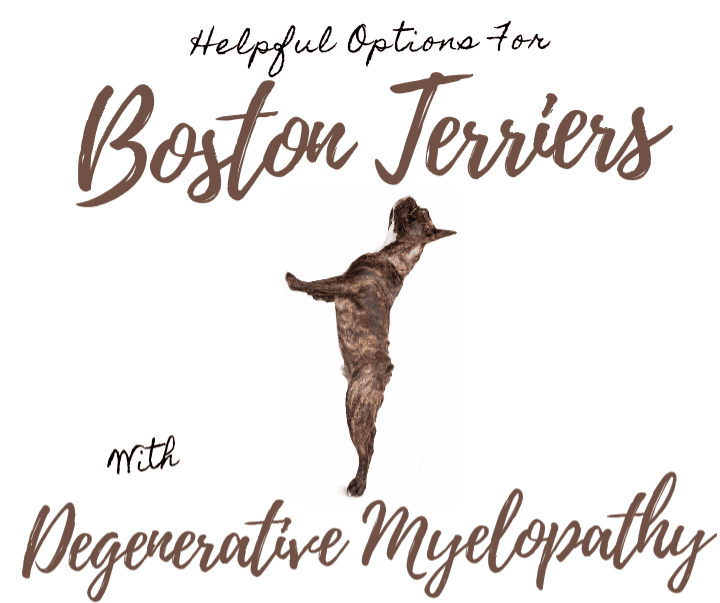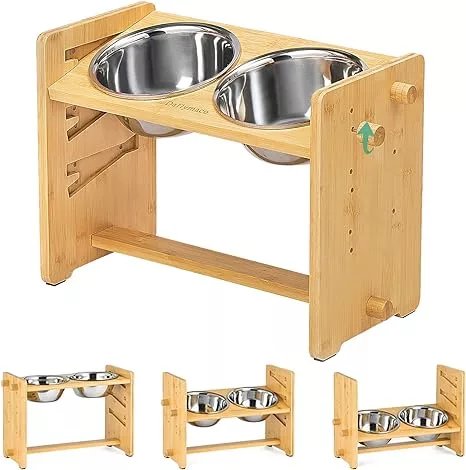Generative Myelopathy in Boston Terriers: Understanding, Coping, and Caring for them
Introduction
Boston Terriers are small, lively dogs that make great companions, but like all breeds, they can face various health challenges. One such ailment that can affect Boston Terriers, as well as other breeds, is degenerative myelopathy (DM). In this article, I will discuss the intricacies of degenerative myelopathy in Boston Terriers, covering its prevalence, symptoms, stages, care, treatment, and prognosis.
How Long Can a Dog Live With Degenerative Myelopathy?
Degenerative myelopathy is a progressive neurodegenerative disease that affects a dog’s spinal cord. Unfortunately, DM is incurable, and it can significantly impact a dog’s quality of life. The lifespan of a Boston Terrier or any dog with DM largely depends on various factors, such as the age at onset, the rate of progression, and the care they receive.
On average, once clinical signs become apparent, dogs with DM typically live for around 6 months to 2 years. However, some dogs may live longer, while others might deteriorate more rapidly. Ultimately, the disease eventually leads to paralysis, making it increasingly challenging for the affected dog to maintain a good quality of life.
Can Boston Terriers get Degenerative Myelopathy ? Is it Common in Boston Terriers?
Yes, Boston Terriers can develop degenerative myelopathy, just like any other breed. While it is not breed-specific, Degenerative Myelopathy is more commonly associated with larger breeds, such as German Shepherds, Corgis, and Boxers. Boston Terriers are not among the breeds with the highest predisposition to DM.
However, it’s essential to note that the disease can still occur in Boston Terriers and other smaller breeds. Genetic factors are believed to play a role in a dog’s susceptibility to Degenerative Myelopathy, but it’s not the sole determining factor. Environmental factors and complex genetic interactions also come into play.
Can Degenerative Myelopathy be Prevented?
Preventing degenerative myelopathy in Boston Terriers or any other breed is a complex challenge. As previously mentioned, DM has a genetic component, and dogs with a genetic predisposition may be more susceptible to developing the disease. While it is challenging to entirely prevent DM, several steps can be taken to reduce the risk:
Responsible Breeding: Breeders should consider genetic testing for DM and other inherited conditions when selecting breeding pairs. By avoiding mating dogs with a history of DM in their lineage, the risk of passing on the disease can be reduced. Click here to read more on Boston Terrier genetic issues.
Diet and Nutrition: Providing a balanced and nutritious diet may help support overall health and possibly reduce the risk of developing degenerative myelopathy.
Exercise and Weight Management: Keeping your Boston Terrier at a healthy weight and providing regular, moderate exercise can contribute to overall well-being and may help prevent obesity-related conditions.
Regular Veterinary Check-Ups: Routine check-ups can help identify early signs of any health issues, including DM.
What are Early Detection and First Signs of Degenerative Myelopathy in Boston Terriers?
The first signs of degenerative myelopathy in Boston Terriers are often subtle and may be mistaken for other conditions. Identifying these early symptoms is crucial for a timely diagnosis and intervention. Some common initial signs include:
- Rear Limb Weakness: Dogs may exhibit weakness or instability in their hind legs, causing them to drag their paws while walking.
- Difficulty Rising: Affected dogs might struggle to stand up from a sitting or lying position.
- Changes in Gait: You may notice a change in the way your Boston Terrier walks, with a wobbly or swaying motion.
- Foot Scuffing: The paws may scrape against the ground as the dog walks, leading to worn-down nails.
- Muscle Atrophy: Over time, muscle loss in the hind limbs becomes apparent.
What are the 5 Stages of Degenerative Myelopathy?
DM progresses through five stages, with each stage representing a different level of severity. Understanding these stages is crucial for assessing your Boston Terrier’s condition and providing appropriate care. The stages of DM are as follows:
- Stage 1: In the initial stage, dogs exhibit mild hind limb weakness, usually affecting one side more than the other. It’s often challenging to differentiate from other common age-related issues.
- Stage 2: At this point, the weakness in the hind limbs becomes more noticeable and symmetric. Dogs may struggle to rise from a lying position and tend to scuff their hind feet while walking.
- Stage 3: The hind limb weakness worsens, and dogs often develop a bunny-hopping gait. They may also have trouble navigating stairs.
- Stage 4: In this advanced stage, dogs lose almost all mobility in their hind limbs. They are typically unable to rise or walk without assistance.
- Stage 5: The final stage is characterized by full paralysis of the hind limbs, and the front limbs may also become affected. Incontinence becomes a significant issue, and dogs may be unable to move without human assistance.
How to Care for Boston Terriers with Degenerative Myelopathy?
Caring for a Boston Terrier with degenerative myelopathy requires patience, dedication, and a focus on improving their quality of life. Here are some essential aspects of care:
- Mobility Aids: As your dog’s condition progresses, you may need to invest in mobility aids like dog wheelchairs to help them move around comfortably.
- Regular Exercise: Gentle physical therapy and range-of-motion exercises can help maintain muscle tone and mobility in the early stages of DM.
- Hygiene and Incontinence Management: Dogs in advanced stages may struggle with incontinence. Regular bathing, diaper use, and cleanliness are vital for their well-being.
- Comfortable Environment: Make sure your home is safe and easily navigable for your dog. Non-slip flooring, ramps, and lower food and water dishes can be helpful.
- Emotional Support: The emotional well-being of your Boston Terrier is as crucial as physical care. Spend time with them, offer plenty of affection, and provide mental stimulation through toys and games.
What are Treatments for Boston Terriers with Degenerative Myelopathy?
While there is no cure for degenerative myelopathy, several treatments and interventions can help manage the condition and improve a dog’s quality of life:
- Physical Therapy: Physical therapy can help maintain muscle mass and joint flexibility. It’s essential to work with a professional therapist to ensure the exercises are appropriate.
- Medications: Your veterinarian may prescribe medications, like Gabapentin, to alleviate pain and inflammation associated with DM. These can help manage symptoms and make your Boston Terrier more comfortable.
- Dietary Supplements: Certain supplements like omega-3 fatty acids and antioxidants may support joint and overall health.
- Assistive Devices: As mentioned earlier, mobility aids like wheelchairs can enable your dog to move around more easily.
- Quality of Life Assessment: Regular evaluations with your veterinarian will help you make informed decisions about your dog’s care, considering their specific needs and stage of the disease.
Is Surgery an Option for Boston Terriers with Degenerative Myelopathy?
Surgery is generally not a recommended treatment for degenerative myelopathy in dogs. The disease primarily affects the spinal cord, and surgical interventions are typically not effective in halting or reversing its progression.
What Home Modifications to Make for a Boston Terrier With Degenerative Myelopathy?
Making appropriate home modifications is essential when caring for a Boston Terrier or any dog with degenerative myelopathy (DM). These modifications are aimed at ensuring a safe and comfortable environment that accommodates your dog’s changing needs as the disease progresses. Here are some key home modifications to consider:
Non-Slip Flooring: To prevent slips and falls, replace smooth and slippery flooring with non-slip options like rubber, cork, or non-slip mats. If replacing flooring is not feasible, consider using adhesive traction strips or rugs with non-skid backing in areas where your dog spends the most time.
Ramp Access: Install ramps with a non-slip surface to help your dog navigate changes in elevation, such as steps or thresholds. Ramps provide easier access to your home, vehicles, and outdoor areas. Ensure that the incline is gradual to minimize the effort required by your dog.
Portable Pet Ramp This pet ramp is highly stable, constructed from lightweight yet durable aluminum, supporting dogs up to 200lbs. It features an anti-slip carpet surface for your pet’s comfort and safety. The ramp is easy to fold and store, with a foam-padded handle for portability. With its collapsible design, it’s versatile for various applications, such as helping pets get into vehicles or high beds, reducing muscle ache and joint tension. Patience and guidance may be needed for pets to adapt to using it.
Clear Pathways: Create wide and unobstructed pathways throughout your home to allow your dog to move freely. Remove clutter and unnecessary furniture, and arrange your living space with your dog’s mobility in mind.
Low-Profile Furniture: Choose lower-profile furniture or place cushions and ramps next to higher seating areas to assist your dog when they want to rest on the couch or bed. This helps your dog access their favorite spots without struggling.
Elevated Food and Water Bowls: Use raised food and water dishes to minimize the need for your dog to bend over, making mealtime more comfortable. Ensure that the bowls are at an appropriate height for your dog’s convenience. This Elevated Dog Bowls stand is adaptable for all life stages, offering six adjustable heights to cater to the specific needs of small, medium, and large pets.
It features a 15° tilted feeding station, promoting healthy digestion and addressing various feeding-related issues, making it ideal for senior dogs. Crafted from natural bamboo wood and food-grade stainless steel, it’s durable and easy to clean. The stand is quick to assemble and disassemble with no tools required, ensuring stability during use. Additionally, it’s convenient and portable, allowing for comfortable feeding at home or on outdoor adventures.
Bathroom Accommodations: If your dog has difficulty reaching the outdoor bathroom area, create an accessible spot within your home using puppy pads or a designated area with a litter box. This helps manage incontinence and keeps your dog clean.
Safety Gates: Use safety gates or baby gates to restrict access to areas that could be hazardous for your dog. For example, block off staircases to prevent accidental falls. The NWK Magic Pet Gate provides an easy way to keep your Boston Terrier safe from stairs in the house.
The NWK Magic Pet Gate is 43 inches wide and 30 inches tall, and it’s not adjustable, so it’s essential to ensure that your door frame is smaller than 43 inches. It features a robust 6-strap design to prevent dogs from passing through. The gate is made from durable, partially see-through fiberglass fabric designed to withstand pet claws and is reinforced with ‘X-shape’ sewing at the joints for stability.
No tools are needed for installation, as it comes with 6 adhesive hooks, 3 spare adhesive hooks, and an installation guide. This gate can be used in various locations around the house, from doorways to walls, stairs, bedrooms, kitchens, and more. It’s suitable for smooth and even walls, with spare screws provided for drywall, but it’s not recommended for rough or uneven wall surfaces.

Slip-Resistant Mats: Place slip-resistant mats near your dog’s resting areas, especially if they have difficulty standing or lying down. These mats provide grip and prevent your dog from sliding on hard surfaces.
Easy-to-Access Essentials: Keep your dog’s essentials within reach. This includes their food, water, toys, and any medication or supplements they require. Place these items where you, or your dog, can access them without difficulty.
A Comfortable Resting Area: Create a cozy and comfortable resting area for your dog. Consider orthopedic bedding and ensure it’s easily accessible. Use blankets or cushions to make lying down more comfortable.
Regular Home Evaluations: Periodically assess your home environment to ensure it remains safe and accommodating as your dog’s condition progresses. Adjustments may be needed to adapt to your dog’s changing needs.
Good Lighting: Ensure that your home is well-lit to help your dog see obstacles and navigate more easily, especially during the nighttime.
Temperature Control: Maintain a comfortable indoor temperature for your dog, as they may have difficulty moving to find cooler or warmer spots as the disease progresses. Additionally, provide cooling mats in warmer months.
The Green Pet Shop Dog Cooling Mat, size Medium, is an excellent choice. This pressure-activated cooling pet mat offers a refreshing escape for your dogs and cats, making it an ideal solution for keeping your pets comfortable during the scorching summer heat.
This innovative pad operates automatically, requiring no water, electricity, or refrigeration. The patented gel formula rejuvenates itself after 15-20 minutes of non-use. If your home lacks air conditioning, this dog cooling pad is a must-have.
Designed for hot summer days, simply place the cooling pad where your furry companion likes to relax. Once your pet rests on the pad, it immediately starts to cool. The sensation is pleasantly chilly and offers instant relief, making it perfect for senior pets or those with medical conditions.
This versatile and portable cooling pad can be used on the floor, sofa, or in your pet’s crate, bed, or kennel. It’s lightweight, easy to fold for travel, and can be cleaned with a damp cloth as needed.
Specially crafted for medium-sized dogs, The Green Pet Shop cooling mat measures 20 x 30 inches, suitable for dogs weighing between 21 to 45 lbs.
Easy-to-Clean Surfaces: Consider using easy-to-clean and stain-resistant materials, especially in areas where accidents may occur due to incontinence.
By implementing these home modifications, you can create a safe and comfortable living environment for your Boston Terrier with degenerative myelopathy. These changes will help your dog maintain their independence and quality of life as they cope with the challenges posed by this progressive disease. Regularly consulting with your veterinarian and adjusting your home to meet your dog’s evolving needs is key to providing the best possible care and support.
What are Helpful Products for Boston Terriers With Degenerative Myelopathy?
Caring for a dog with degenerative myelopathy (DM) involves various products and supportive measures to help improve their quality of life. Here are some product suggestions to consider:
Dog Wheelchair: A dog wheelchair is a crucial tool for dogs with advanced Degenerative Myelopathy. It allows them to move around independently and maintain their mobility. Measure your dog carefully to ensure a proper fit, and choose a sturdy, adjustable wheelchair.
This small dog wheelchair for back legs, also known as the Pet Mobility Aid, is designed to restore independence to pets with injured or disabled hind legs, allowing them to walk, run, and play once more.
Key features of the latest design include wider and larger tires, enhancing your pup’s ability to navigate complex terrains and interact with other pets. The tires rotate smoothly with bearing connections, ensuring ease of use and extended tire life.
Quality and comfort are paramount in our pet wheelchair for back legs, featuring a high-hardness yet lightweight frame for durability. Soft straps guarantee a secure and painless fit for your pet, and a specially designed mesh pocket adds extra comfort around your pet’s belly.
It’s important to note that this two-wheel aid, our small dog wheelchair for back legs, is intended for pets with healthy forelimbs, impaired hind legs, and aging pets.
Orthopedic Dog Bed: Provide your dog with a comfortable orthopedic dog bed that supports their joints and provides relief from pressure sores. Look for beds with memory foam or other supportive materials.
Furhaven Orthopedic Dog Bed is designed for medium-sized dogs, offering ample room for various sleeping positions. It features gusseted sides for added cushioned loft, providing enhanced comfort for nestling and lounging. The sleep surface is covered in plush curly faux fur for cozy snuggling. The egg crate orthopedic foam mattress supports joints, distributes body weight, and improves air circulation for better sleep. The product comes in gray, size medium (30″ x 20″ x 3″) and includes a 90-Day Limited Coverage against material defects and potential eligibility for a 60-Day Worry-Free Program, subject to certain restrictions.
Non-Slip Flooring: To prevent slipping and accidents, consider using non-slip rugs or adhesive traction strips on slippery surfaces in your home. This helps your dog move around more easily.
Dog Ramps: Ramps can be helpful for dogs with Degenerative Myelopathy to access vehicles, stairs, or other elevated surfaces. Look for sturdy, non-slip ramps that are suitable for your dog’s weight and needs.
Dog Diapers: Incontinence can become a concern as the disease progresses. High-quality, well-fitting dog diapers can help manage accidents and keep your dog clean and comfortable.
Grooming Tools: Special grooming tools like mats and brushes designed for dogs with mobility issues can make it easier to maintain their coat and overall hygiene.
Dog Sling or Belly Band: These assistive products help support your dog’s hind end when they need help standing or walking. They are especially useful for dogs in the later stages of DM.
The 4-120 lbs Dog Lift Rear Legs Support Harness is designed to assist elderly, disabled, or injured dogs who face challenges with stairs, mobility, and the risk of falling. It serves as a lifeline by lifting the rear end, preventing hip pain and aiding in tasks such as car entry, stair navigation, standing up from lying down, and ensuring stable gait and spine support.
Additionally, it plays a crucial role in postoperative rehabilitation for dogs recovering from surgeries. The harness is soft and comfortable, featuring synthetic fleece on the inside for a gentle feel against your dog’s belly and sturdy oxford fabric on the outer cover. It’s user-friendly with padded handles for easy lifting, washable, and conveniently portable with a drawstring bag. This size-adjustable harness is suitable for medium to large dogs, with an adjustable length ranging from 49 to 68 inches.
Paw Protectors or Boots: To protect your dog’s paws from abrasions and scrapes, consider using paw protectors or boots when they are outside or moving around indoors.
Expawlorer 4PCS Anti-Slip Dog Shoes. The boots are made from superior materials, featuring reflective material and a skid-resistant design for nighttime visibility and safety. They are also waterproof, keeping your pet’s paws dry in rainy or snowy conditions. The design offers comfort with flexible lug patterns and a grooved sole for better control and protection. Two fastener straps make the boots easy to put on and take off.
The Size 2 dog boots measure 2.28″x1.89″ (L*W) and are suitable for dogs weighing 18-27 lbs, such as Dachshunds and French Bulldogs. To ensure a proper fit, follow the measurement instructions by marking the width and length of your dog’s paw on a piece of paper and measuring the distance, as demonstrated in the video guidance.
When selecting the right size, use the inside dimensions of the boots, focusing on the width. If your measurements fall between two sizes, it’s advisable to choose the larger one.
Anti-Inflammatory Supplements: Consult with your veterinarian about supplements that may help manage inflammation and provide joint support. Omega-3 fatty acids and antioxidants can be beneficial.
Joint Supplements: Glucosamine and chondroitin supplements can support joint health and may help alleviate discomfort associated with Degenerative Myelopathy.
Puzzle Toys and Mental Stimulation: Keep your dog mentally engaged with puzzle toys and interactive games. These can help maintain their cognitive abilities and provide entertainment.
Snuffle Mat for Dogs will keep your pup occupied without the need for much movement.
The Dog Training Mat is a valuable tool for dogs with Degenerative Myelopathy. It encourages them to forage naturally, making mealtime more engaging and stimulating their senses. This snuffle mat lets dogs search for hidden treats, slowing down their eating pace and preventing digestive issues, which is especially important for dogs with degenerative myelopathy.
The mat is made of high-quality and durable materials, featuring artificial grass blades and additional feeding games for smarter dogs. It also includes a BB device to pique your dog’s interest. The non-slip bottom keeps the mat in place and can be tied to furniture to ensure stability, making it suitable for both indoor and outdoor use.
In addition, the mat is easy to clean, ensuring the health and well-being of your dog. Its size is suitable for various breeds, and it provides mental stimulation and entertainment for dogs with mobility issues like Degenerative Myelopathy.
Medications: Your veterinarian may prescribe medications to manage pain, inflammation, or other symptoms associated with DM. Be sure to follow your vet’s recommendations.
Home Modifications: Consider making home adjustments such as installing ramps, ensuring clear pathways, and creating a safe and comfortable environment for your dog.
Regular Veterinary Care: Frequent check-ups with your veterinarian are essential to monitor your dog’s condition, adjust treatment plans as needed, and ensure they receive the best care possible.
What is the final stage of Degenerative Myelopathy in dogs?
During the advanced stages of Degenerative Myelopathy (DM), your dog will depend on your assistance for mobility. When a DM-affected dog’s hind legs become paralyzed, they lose the ability to stand, get up, or walk independently. As DM progresses to the late stages, you will observe significant changes in your dog’s mobility.
When to Euthanize a Boston Terrier With Degenerative Myelopathy?
Frequently, dogs are compassionately put to rest within six to twelve months after the appearance of clinical symptoms, as this disease severely impairs their mobility. Without euthanasia, DM can advance for over three years, ultimately resulting in an inability to walk and even breathe properly.
Remember that every dog’s needs are unique, and it’s essential to consult with your veterinarian or a veterinary specialist who can provide personalized recommendations for your Boston Terrier with degenerative myelopathy. With the right products and care, you can help your dog maintain their comfort and mobility as much as possible throughout their journey with Degenerative Myelopathy.

https://healingpawsfl.com/degenerative-myelopathy-in-dogs-what-can-you-do/
https://k9carts.com/breeds/boston-terrier-health-problems/
This post contains affiliate links. I earn from qualifying Amazon purchases.












